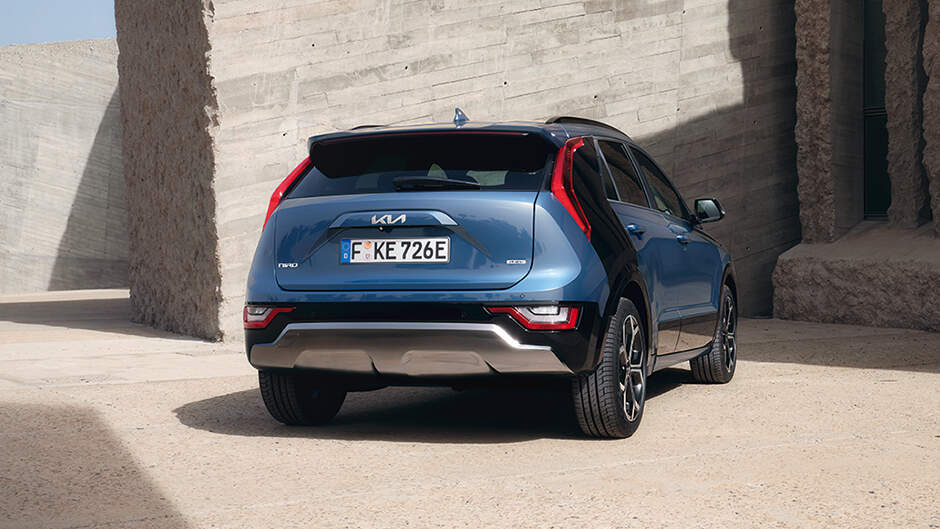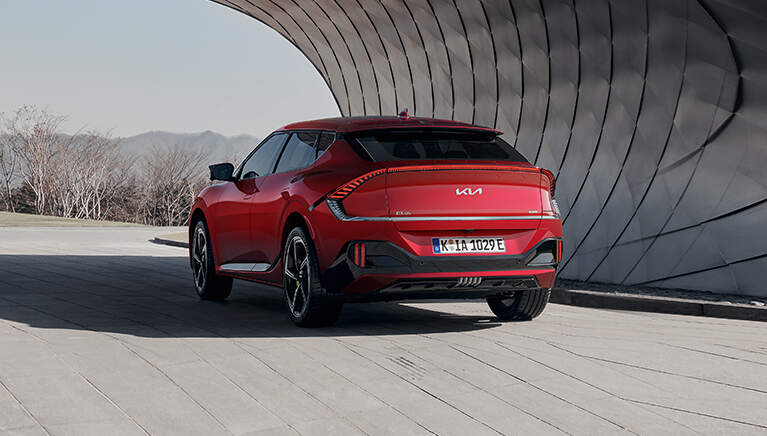The Truth About Electric Cars
_Desktop_1920x364.jpg)
The truth about electric cars: Common questions and claims answered by Kia
With so much information and debate about electric vehicles, it can be hard to decide whether an EV is right for you or good for the planet. To help, we've investigated the truth about electric cars and responded to some of the most common questions, and claims and myths.

#1: There aren’t enough public charging stations.
The recent boom in the sale of electric cars
it is causing many to wonder if there are enough public charging stations. Our view at Kia is that things are actually going in the right direction.
Why?
Do you remember passing by empty EV station parking bays? So far, the utilisation rate of public stations has been extremely low, as operators built stations ahead of demand. This is no doubt increasing, but while queues make headlines (similar to when petrol stations run dry), they’re still isolated events at even the most popular stations.
The UK’s charging network is also undergoing massive expansion. Between February 2022 and February 2023, the UK’s public charging network has grown by 17 percent (29,654 to 34,965 stations). Many of these newly installed stations are delivering much higher power, allowing faster charging for longer journeys for compatible vehicles like Kia models.
The number of high-power stations – some now delivering power as high as 350kW – has increased by 39 percent over the same 12-month period. While in September 2020 the UK only had 2,165 DC stations (11 percent of all stations), this had grown to 5,700 by February 2022 (16 percent of all stations).
Public stations are seeing higher utilisation, but this is still low. The infrastructure is also expanding fast, with an emphasis on extremely powerful stations supported by the current range of Kia electric vehicles
and delivering charging times that would have been unthinkable just a few years ago.
LEARN MORE ABOUT PUBLIC CHARGING

#2: Because of their batteries, electric vehicles are more harmful to the environment than internal combustion or hybrid vehicles.
Climate change is one of the greatest threats to human life we have ever faced. The global community has rallied around the goals of the Paris Agreement
and the UN Framework for Climate Change to keep temperature increases within certain boundaries. Transitioning to electric vehicles is one way we can potentially reduce these temperature increases. There are two significant reasons for this:
1. Sustainable Mineral Mining
- While we have to increase the extraction of certain minerals, there are enough at our disposal. The CO2 emissions generated by this activity are also offset by far greater environmental gains further down the line.
You can read more about this in an article published by MIT.
2. Well-to-Wheel Greenhouse Gas Footprint -
While sizeable batteries means that electric vehicles generate more CO2 than internal combustion engine (ICE) or hybrid cars during production, this is significantly reduced when driving EVs. As a result, the whole lifecycle (‘Well-to-Wheel’) greenhouse gas footprint of an electric vehicle – including its recycling - is much lower than an internal combustion engine or hybrid vehicle. This has been confirmed at the UK level and forms the basis for the UK’s Road To Zero Strategy.
Kia is actively engaged in measuring the whole lifecycle environmental impact of our EVs and driving this impact down. Our Niro EV
and EV6
were subjected to a Life Cycle Assessment, which measured their end-to-end environmental impact over 10 years or 200,000 km, otherwise referred to as ‘Well-to-Wheel’ impact. This assessment is based on internationally recognised methodologies (i.e. ISO 14040 and ISO 14044). In addition, we used the widely used CML* method to measure the potential environmental impact in six categories, including global warming, abiotic depletion, and ozone depletion.
_940x529.jpg)
#3: Driving an electric car isn’t clean because the grid isn’t clean.
There are two main reasons why this claim is false.
1. Energy-to-Power Conversion
Electric vehicles are more efficient at converting energy into power. Replacing petrol-powered cars with EVs saves energy, regardless of the energy source used to recharge them.
Average ICE vehicles only send between 16 to 25 percent of the energy created from burning petrol to the wheels. The rest is lost to heat, noise or mechanical forces. With innovative technology like regenerative braking that sends energy back to the battery, electric vehicles send 87 to 91 percent of the energy in the battery to the wheels.
2. The EV Grid is Decarbonising
Burning fuel will always be harmful to the environment. However, our electricity is drawing from a grid that is quickly decarbonising.
In 1991, renewables accounted for just two percent of all electrical generation in the UK. Zero-carbon power in Britain’s electricity mix has grown from less than 20 percent in 2010 to over 50 percent in February, May, October, November and December of 2022. In contract, coal power was responsible for only 1.5 percent of electricity generation in 2022, compared to 43 percent in 2012.
If we combine renewables with other low-carbon electricity sources, such as nuclear 16 percent, and the UK’s green infrastructure is getting closer to reaching the government’s 2035 target and ultimately reaching net zero in the specified time frames.

#4: Using public charge points is hard, with many apps, subscriptions, payment methods and unclear pricing.
The myriad of companies across the public charging landscape in the UK and Europe has until recently previously made access to chargers quite difficult. However, this period is now over for most operators, thanks to ground-breaking ‘roaming’ solutions like Kia Charge.
These solutions consolidate all UK and European networks into one account. You can easily see and access all stations available using just one app or card, wherever you go. Kia Charge currently offers the highest level of coverage, with 85 percent of UK stations available.
Contrary to what many people think, these solutions do not necessarily charge higher fees. In fact, when considering the different subscriptions available, Kia Charge can be more financially advantageous than dealing directly with an operator. You may also pay less when using Kia Charge rather than contactless payment, as some operators charge a premium on contactless. Some operators inside the UK and many outside the UK don’t offer contactless payments at all.
FIND OUT ABOUT KIA CHARGE

#5: Electric vehicles’ batteries discharge when left parked for several days or weeks.
Kia EV’s can be left parked for extended periods of time without any noticeable decrease in battery level.
_940x529.jpg)
#6: Electric vehicles take too long to charge.
Electric car technology
has evolved significantly over the last few years. This has resulted in better charging performance by vehicles and the growing availability of high-power charging.
At Kia, we have introduced our e-Global Modular Platform,
starting with the EV6. This brings ground-breaking 800V charging, enabling 10-80 percent charging in just 18 minutes at stations above 240kW power.
And if you’re able to charge at home, you can recharge your EV while it’s parked and leave the house every morning with with a full battery, all the energy you need, and more.
FIND OUT MORE ABOUT EV CHARGING
_940x529.jpg)
#7: Electric vehicles are slow and uninspiring to drive.
A few seconds behind the wheel of an electric car
is enough to debunk this myth.
Kia EVs deliver instant torque and exhilarating performance. As you’d expect, our flagship EV6 GT
is no slouch with 0-60mph acceleration in 3.5 seconds, drift mode and powerful brakes.
Other models in the Kia line-up provide a similarly exceptional performance. Even the least powerful version of the EV6 still accelerates from 0-62mph in 7.3 seconds. Its sibling with our grippy e-AWD system does the same sprint in just 5.2 seconds. Our Niro EV’s 0-62 acceleration is an equally impressive 7.8 seconds, leaving many hot hatches behind.
But beyond their performance, Kia electric cars are just fantastic cars to own and drive. Our first-generation e-Niro was voted What Car? Car of the Year in 2018 while our EV6 obtained this distinction in 2022 in addition of being awarded the prestigious 2022 European Car of the Year Award. Our EV9
was also the most anticipated new car of 2023, as illustrated by the What Car? Reader Award it received. This speaks volumes as to the quality and appeal of Kia electric cars versus other options.
FIND OUT ABOUT KIA ELECTRIC CAR PERFORMANCE
_940x529.jpg)
#8: Electric cars are too expensive.
Kia electric vehicles do have a higher price than petrol or hybrid counterparts; however, this doesn’t tell the whole story.
Our electric vehicles’ running costs can prove particularly low. With the right set up to charge your car at home,
work, or at public stations, you’ll have a lower pence-per-mile running cost than most petrol, diesel or hybrid cars. This is still true despite recent energy price hikes since the war in Ukraine.
Kia electric cars can also prove comparatively economical to maintain. They have fewer moving parts than conventional vehicles, and technologies like regenerative braking minimise the wear and tear of the braking system.
You can also leverage numerous savings when driving electric vehicles. These include electric car tax benefits,
exemptions to Congestion Charges or lower parking fees. Electric company car
drivers and companies themselves can also cash in on lower taxes, through company car taxation and full capital write-down.
Finally, have you considered a used electric car?
More used electric vehicles are now available from our Kia dealer network. They are more affordable than new vehicles and, like any Kia Approved used car,
benefit from a comprehensive 7-year warranty from the day you drive away.
BROWSE OUR USED ELECTRIC CARS

#9: Electric vehicles are more dangerous in an accident.
Electric vehicles are subject to the same safety tests and standards as regular cars and are often found to be as safe or safer.
All Kia electric cars are crash-tested by EuroNCAP – a completely independent and very demanding industry body – and achieve excellent scores. Our cars are also equipped with a suite of state-of-the-art active safety systems, like Lane Keep Assist or Forward-Collision Avoidance Assist, that will help you avoid accidents.
You can consult the EuroNCAP results for all our models online.

Images shown are for illustration purposes only and may not be to full UK specification. Features shown are not standard across the Kia model range and availability will vary dependant on model. For further details please refer to the individual model specification sheets.

